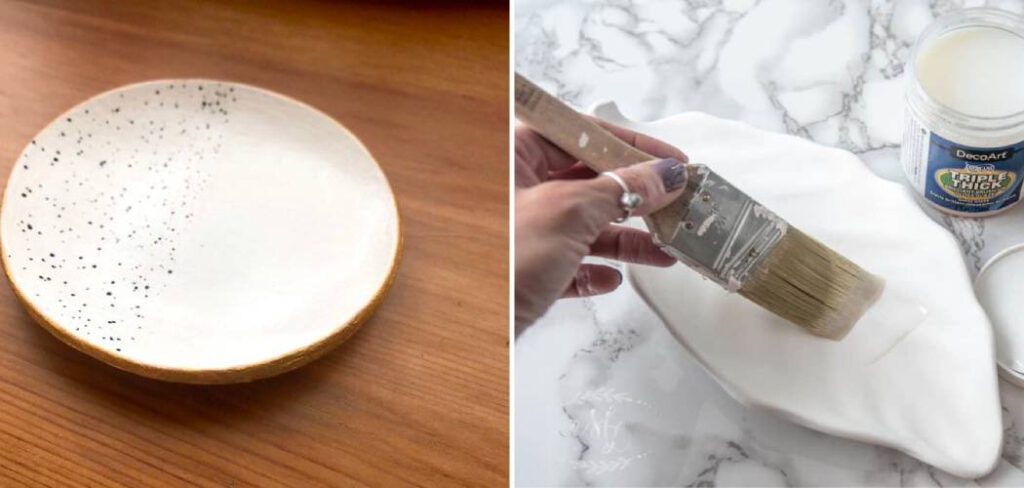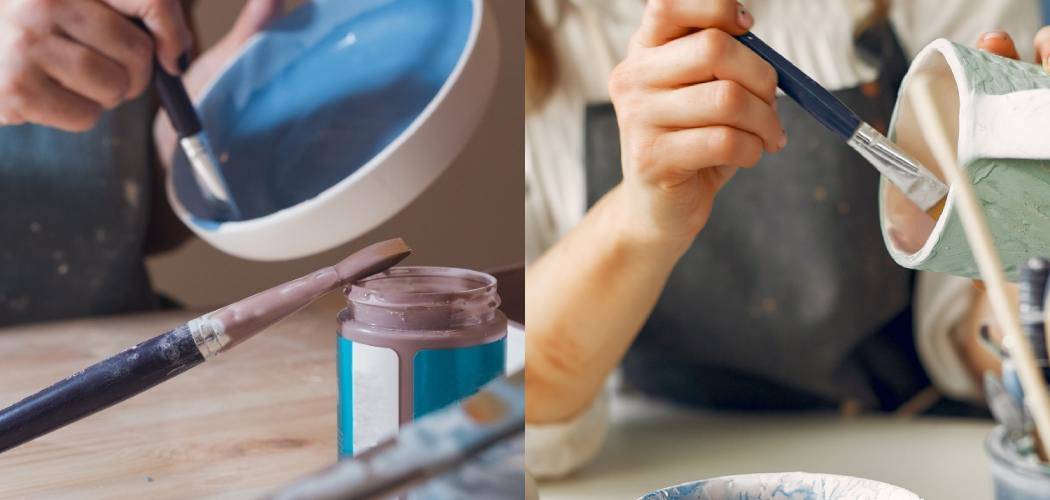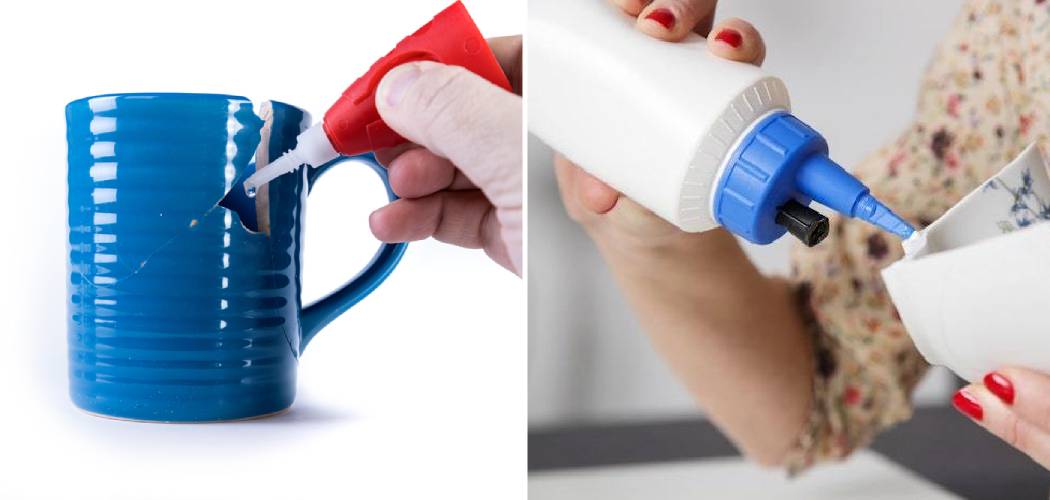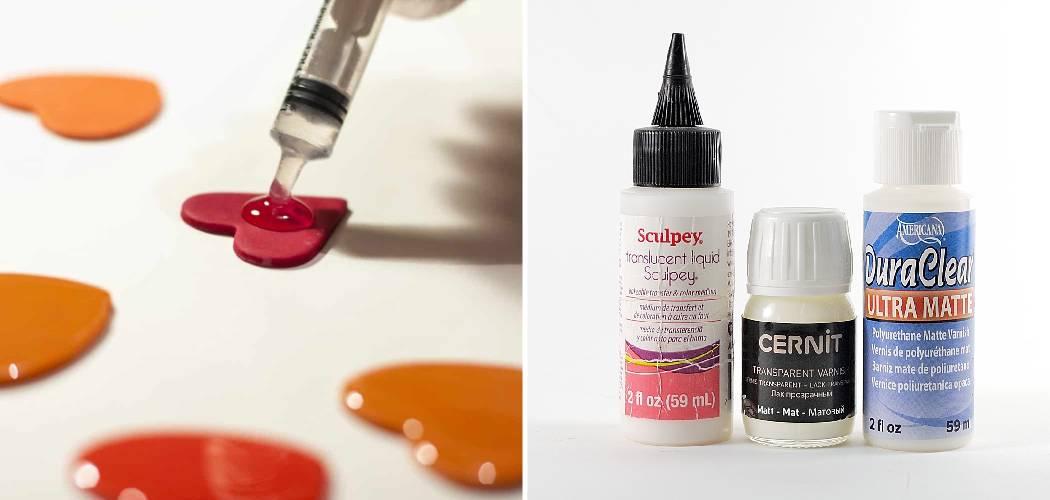Air-dry clay is an incredibly versatile medium for crafters, providing endless possibilities when it comes to creating unique and interesting works of art. Whether you’re crafting with children or you’re a professional artist, air dry clay is easy to use and doesn’t require any special equipment or specialized knowledge–just some air drying time.

But the real challenge in utilizing this type of clay is ensuring that it’s food safe after it’s dried. The good news is that sealing air-dry clay can be done at home fairly easily, using either varnish sealers or mineral oil! In this blog post, we’ll provide all the tips and tricks on how to seal air dry clay food safe and ready for use as a decorative piece in your home!
To seal air-dry clay to be food-safe, use a food-grade sealant or varnish. Apply a thin, even coat, and follow the product’s instructions for drying and curing to ensure it’s safe for use with food.
Table of Contents
The Importance of Food Safety when Working with Air Dry Clay
When working with air dry clay, it’s important to take food safety into consideration. After all, air-dry clay is not a food-safe material; if something made of air-dry clay were used to hold or serve food, the porous surface could act as a breeding ground for bacteria and other contaminants. With that in mind, those who work with air dry clay should make sure they take the necessary steps to seal their projects and ensure that their work is food safe.
The first step in making an air dry clay project food-safe is to ensure it is completely dry before it comes into contact with food or other consumable products. This means allowing the air dry clay to sit undisturbed for at least three days, or longer if the project is thicker or more complex. Once it’s dry, you can use a sealant to create an extra layer of protection against bacteria. Many people choose to use a food-safe varnish or glaze for this purpose; however, there are other sealants that may be suitable as well.
Exploring the Benefits of Sealing Air Dry Clay for Food Contact Items
Sealing air dry clay is an important step in the process of creating food contact items such as decorative plates or platters. Not only does sealing give your creations a professional look and feel, it also ensures that they are safe to use with food. Here are some of the benefits of sealing air dry clay for food contact items:
1) Protects Against Contamination:
Sealing air-dry clay prevents contaminants such as dirt, bacteria and oils from entering into contact with the food you serve. This is especially important when making plates or platters where food may sit directly on top of the clay surface. When properly sealed, you can rest assured that your guests and family members will be protected against any unwanted germs or bacteria.
2) Prevents Staining:
Air-dry clay can easily be stained by food and liquids. Sealing your creations with a food safe sealant will help prevent staining from occurring, ensuring that your beautiful pieces stay looking like new for years to come.
3) Enhances Durability:
By sealing air dry clay, the material is better able to hold up against wear and tear caused by everyday use. This makes it perfect for creating plates or platters that will get regular use in the kitchen. So no matter how often you serve meals on your decorative pieces, they’ll remain durable and intact for years to come.
10 Methods How to Seal Air Dry Clay Food Safe
Method 1: Selecting Food-Safe Clay
Start by using an air dry clay that is labeled as food safe or non-toxic. It is important to choose a clay brand that explicitly states it is safe for food contact to ensure the best results. However, some brands are not labeled as food safe but may still be safe for use with food items. Research each clay brand thoroughly to determine if they have been tested and proven to be non-toxic.
Method 2: Handwashing and Cleaning
Before working with air dry clay, thoroughly clean your hands and the working surface to remove any potential contaminants. This step helps maintain a hygienic environment during the crafting process. Once your hands and workspace are clean, it is important to keep them that way. Avoid touching your face or hair while working with air dry clay.
Method 3: Properly Shaping and Forming
When creating food-related items with air-dry clay, pay attention to the shaping and forming process. Ensure that the clay is molded evenly and there are no cracks or crevices where bacteria or food particles could accumulate.
Method 4: Smoothing and Sanding
Smooth the surface of your air dry clay creations using sandpaper or a fine-grit sponge. This step helps to remove any rough edges or imperfections, making it easier to achieve a food-safe finish. Once the surface is smooth, apply a sealant to your clay item. There are several options for sealants that make air dry clay food safe, such as polyurethane, lacquer, shellac, or even food-grade mineral oil.
Method 5: Choosing a Food-Safe Sealant
Select a sealant specifically formulated for food contact. Look for products labeled as food safe or non-toxic and read the instructions carefully to ensure their suitability for use with air dry clay. Some common sealants used for food safe air dry clay projects include polyurethane varnish, shellac, and beeswax.
Method 6: Applying a Clear Glaze
Using a brush or sponge, apply a food-safe clear glaze to the surface of your air dry clay creations. The glaze forms a protective barrier that seals the clay and prevents any potential contaminants from coming into contact with food.
Method 7: Curing and Drying
Allow the clear glaze to cure and dry completely according to the manufacturer’s instructions. This step is crucial to ensure the effectiveness of the sealant and the safety of your food. Depending on the type of glaze used, this process may take anywhere from several days to a few weeks.
Method 8: Reapplying the Sealant
For added protection, consider applying multiple coats of the food-safe clear glaze. Make sure to allow each coat to dry fully before applying the next. This will provide a more robust seal and increase the longevity of your air dry clay creations.
Method 9: Testing for Food Safety
Perform a food safety test before using your air dry clay creations with food. Apply a small amount of the food you intend to use on the clay surface and leave it for a period of time. Check for any discoloration, texture changes, or odor transfer to ensure that the sealant is effective and the clay is food safe.
Method 10: Regular Maintenance and Care
To keep your air dry clay creations food safe, it is important to handle them with care. Avoid using sharp utensils that may scratch the sealant, and clean the items using gentle dishwashing techniques. Regularly inspect the sealant for any signs of wear or damage, and reapply as needed to maintain the food-safe properties.
Some Common Mistakes when Sealing Air Dry Clay Food Safe
When it comes to sealing air-dry clay food safely, there are some common mistakes that people make. One of the most common mistakes is not using enough sealer. It is important to use enough sealer so that the entire surface of the clay is covered and sealed properly.
1. Not Using a Food-Safe Sealer:
Make sure that the sealer you use is specifically designed for sealing air dry clay, and is also food-safe. If you don’t, the sealer may not be able to protect the clay from water or other liquids which could contaminate it and make it unsafe for food.
2. Not Prepping the Clay:
Before you apply sealer to your air dry clay, make sure that the surface is clean and free from dust or debris. If there are any imperfections in the clay, fix them first before sealing. This will ensure that the sealer can adhere properly to the entire surface of the clay and provide an even seal throughout.
3. Using Too Thick a Layer of Sealer:
Using too much sealer can lead to a thick coating that won’t be able to cure properly, leading to a weak and uneven seal on your air dry clay piece. Instead, use multiple thin layers of sealer so that each layer has a chance to cure and adhere properly.
4. Not Curing the Sealer:
Most sealers need to be cured in order for them to form a proper protective barrier around your air dry clay. Check the directions on the sealer you are using and make sure that you follow all of the instructions carefully so that you get a good seal.
Conclusion
In conclusion, sealing air-dry clay food safe is an incredibly helpful technique for those looking to take their projects to the next level. By following these instructions and using either PVA glue or water-dilutable varnish as a sealant, you can make sure your creations will last a long time without having any adverse effects on the food put on it.
If you have any doubts as to whether or not your sealant is food safe, it is better to err on the side of caution and throw out the item. It’s now up to you to create works of art that will not only look great but also keep the food secure and healthy for longer periods of time!For further information about how to seal air dry clay food safe, feel free to reach out with any questions. We’re here to help!





